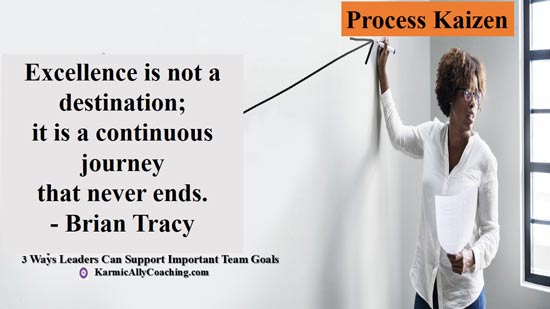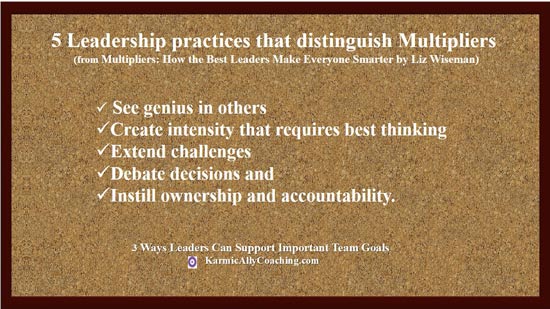This post has already been read 933 times!

A good leader knows their true success in that role requires finding the balance between team members achieving their individual goals while working on important team goals that flow into achieving organization goals.
Targets and goals flow top down through the management chain of command to operational level. As a team leader, it’s important you support your team to reach its targets and goals.
You will be put in charge of a group by your managers. The reason being so you can help them to get the business to where they think it needs to be.
This will most likely translate into earning a certain amount of profit, taking on a certain number of new clients, or perhaps turning over more work.
It could also include creating more effective and efficient processes that raise productivity and margins.
Your ability to deliver results will advance your career and open the doors to a leadership track.
Whatever the case, you need to decide how to help your team to get there.
So how do you do that?
Break the Big Goal into Smaller Achievable Goals
As with all big goals, your 1st step is to break those overarching targets down into smaller and more achievable goals. This will help you to see whether or not you are on track to meet the targets at any given point.
Set up milestones to mark each step towards the big goal within an expected time frame.
Always leave a time margin while setting up the milestones. Tight milestones leave little space for error and leeway.
And as we all know, even the best plans can get derailed when we’re working on them. We are required to take into account new information and events that might occur.
It’s not a good idea to try and race toward a deadline as it creates a stressed atmosphere. It will likely lead to you getting behind schedule which can be very difficult to recover from.
Instead, set SMART Goals and then break into milestones that mark progress towards that big goal.
Sometimes a project requires a multi-talent team with members joining from different departments with different skill sets and expertise.
As a good team leader, it’s your job to get every individual in the team to work together as a unit. I go into more detail in my post 5 ways a good group leader improves individual goal achievement.
Assign roles to members of the team and placing them correctly to do their best work. That means further dividing the work you need to do into small and precise chunks.
Think about who is best to tackle each of those chunks, and how best to motivate them to tackle them.
Apply Process Kaizen
The next thing to think about is efficiency.
This is sometimes referred as “process kaizen,” which essentially means honing in on small changes you can make to daily processes, which can save large amounts of time and energy in the long run.
According to LeanProduction, Kaizen (Continuous Improvement) is a strategy where employees at all levels of a company work together proactively to achieve regular, incremental improvements to the manufacturing process. In a sense, it combines the collective talents within a company to create a powerful engine for improvement.
As a leader, you can build a cohesive efficient team by encouraging them to think outside the box . Offer suggestions and implement improvements that enable tasks to be completed in time and achievement of milestones for the project.
Sometimes we don’t even realize we are applying the Kaizen philosophy or implementing the PDCA (Plan, Do, Check, and Act) approach to achieve team targets and goals.
For example, at the start of an audit, the Team Leader holds a planning meeting where the audit team including specialists from other departments like Tax and IT. Their skills will be required to plan the strategy and approach for a successful audit in order to issue the Auditor Report for the client.
The team can make suggestions on how to achieve this goal within time limits and budget. The Tax and IT experts might give suggestions to reduce their charge to the audit. They’ll ask for specific documents or information to be collected by the audit team who would be onsite before they commence their work.
A good leader will encourage the team to use their creativity and also follow up on the progress with regular checks and change in work plan if required.
Process Kaizen would also be seen at the end of the audit during the debriefing meeting where the team would assess what went right and where they can improve the process for the next audit.

Be the human equivalent of a Force Multiplier
I’m sure you’d remember this phrase from your Physics class back in school!
A force multiplier is anything that you can use in order to get more work done more quickly, without putting in more energy.
An example is a forklift – this multiplies the amount of palettes that a single person or a team can move exponentially!
Computers are also force multipliers, and making sure that everyone’s works to the best of their ability is a huge way to make sure they’re able to work as quickly as possible.
I’d venture to say your television remote control device is a force multiplier too!
When it comes to work and leadership, according to Liz Wiseman, Author, Multipliers: How the Best Leaders Make Everyone Smarter there are 2 types of leaders – Intelligence Multipliers and Diminishers.
Leaders who use their intelligence to amplify the capabilities of people around them are Multipliers of intelligence.
because they inspire employees to stretch themselves to deliver results that surpass expectations. They assume that their team members are intelligent people and will figure out solutions on their own.
This core assumption is at the root of the five leadership practices that distinguish Multipliers.

As a result, Multipliers get better results from their people. They give opportunities to their team members to improve their skills and learn more.
On the other hand, Diminishers see a limited number of smart people. They assume that no one else will figure things out without them. It’s not their fault, really.
These leaders are promoted based on their skills, but management often forgets that the skills that helped them get the promotion is not sufficient in a leadership role where soft and people skills like Emotional Intelligence become key to their success.
Even if you as a team leader find yourself playing the role of a Diminisher, it’s never too late to change provided you’re ready to shift your mindset and do what it takes to become a Multiplier.
The choice rests with you.
How to Get the Most Out of Team Members
Being a leader is truly about taking a step back, and about allowing your team to really perform their best work.
Rather than “taking the bull by the horns” or attempting to micromanage your staff, allow individual creativity and talent of each person to shine. That’s why they were hired in the first place, after all!
So how do you do this? How do you go about getting the most out of each individual team member?
Here are some useful points to keep in mind.
Make them Feel Safe
One of the most important roles of any leader is to make the team feel safe. In a work place environment, this will often mean that you are taking on responsibility, such that they don’t take the blame when things turn sour.
This requires some practice and knowing where to draw the line.
If your team know you will blame them for every mistake that they make, then they won’t be able to take creative risks.
Likewise, if they are terrified of layoffs and higher management, then they’re not going to work well either!
Know their Skills
Consider is how each of your members operates as an individual and how best they can be integrated into a team.
Different people have different skill sets and work better in different capacities. This means that different people will work better in certain groups and in certain positions within those groups.
If you have someone who is a born leader, then of course that person is an asset to any group. That is, unless that group already has a born leader in place in which case you are going to cause friction.
I remember a project where I had a team with not one but 3 born leaders!
It was a challenge in the beginning figuring out how to give each of these talented individuals a chance to shine in their work while keeping everyone in a team format.
It required thinking about how each new member fitted into the dynamic of the core team and then choosing how I assembled the mini teams based on this.
Being sensitive to the entire team and presenting the mini team break down was important. Everyone had to understand how we were dividing the work in order to save time while allowing each person to play on their strengths.
It made life easier because doing this allowed me to know who to assign to each task when they were required to work independently and help them discover their blue ocean for career progression.

Give them Ownership over their work
One of THE most important tips for any leader, is to give members of the team a sense of ownership over what they are doing.
While it’s your job to take responsibility when things go wrong, you should also make sure that they have something to show for their hard work, and that they have control over. If it goes well… they get all the credit!
When someone isn’t working their best, it normally isn’t because they are “bad workers”. Instead, it’s because they don’t feel intrinsically motivated by the work they’re doing.
Give them a project that they can do on their own with their existing skills that can be further developed in the project along with some creative control that they can add to their CV.
You’d be amazed at how well the person will perform. An intelligent professional will know they are being given an opportunity to shine and advance their career.
In my younger professional years, I was lucky to work with team leaders who took their team along with them. We were given opportunities for further development. They doubled up as mentors too.
Those were the role models I emulated in my later years and achieved a lot more than successful project completions.
Bonds of mentorship and long-lasting relationships are developed that continue even after the project or change in job.
That’s what true leadership is all about. Being remembered with high regards by a team member long after they’ve ceased to be a team member and become a leader in their own right!
Additional Resources for Leaders who want to create great Teams
Karmic Ally Coaching Leadership Guide and Planner
Get the guide and planner directly for $17
Good leaders actually know the effect of Do as I say Not Do as I do
Multipliers: How the Best Leaders Make Everyone Smarter, Liz Wiseman
The Force Multiplier: How to Lead Teams Where Everyone Wins, Tony Chatman
Karmic Ally Coaching’s Complete Leadership Toolkit







 I adhere to the Certified Coaches Alliance Code of Ethics and Standards. A copy is available on request.
I adhere to the Certified Coaches Alliance Code of Ethics and Standards. A copy is available on request.
 Let's Talk through the Connect Form:
Let's Talk through the Connect Form: